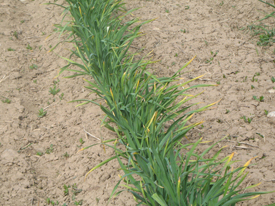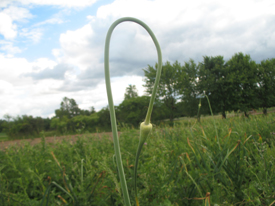
The first thing that we do is to choose the kind of garlic to grow. There are two basic types: hardneck (stiffneck or topset) and softneck. Within the two types there are many subspecies and varieties. Generally hardnecks will have cloves growing around a central woody stem and the flavor is usually hotter than the softnecks. Softnecks may have many cloves growing around a center clove or a large number of center cloves. Most of the garlic that you buy at the local supermarket is softneck and grown in California, China, Mexico and other parts of South America. Many of these softnecks do not grow well in northern climates.
For best results, planting should occur in northern climates after Sept. 15th and before Nov. 30th. Due to climate change, we are beginning to see a lot of precipitation during the month of October and beyond. So the recommendation is to try and plant or at least have your soil prepared before the end of September. You may also Spring plant, but the resulting heads are much smaller because the garlic did not have the opportunity to develop a good root system.
The site where you would like to grow your garlic should be a sunny, well drained spot with a soil that has a fair amount of organic matter. Clay and sands are OK, but the key is organic matter like compost or vegetative mulches. Loosen the soil and make a furrow about 1″ deep. Place each clove root tip down, 4 to 6 inches apart in the furrow. It’s also very important that the PH level is between 6.2 and 6.8.

Just before planting, split the cloves off from the head of garlic. You may use a fertilizer or compost higher in Phosphorous (P) and Potassium (K) to ensure good root development throughout the cold months. Cover the clove and pile on 4 inches of soil or mulch. This helps prevent heaving during the freezing winter months. The plant will begin to emerge in March. This is a good time to feed the garlic with a fertilizer high in Nitrogen (N) to promote top growth and eventually good bulb formation. Keep the area weed free and in the first week of June your hardneck varieties will begin to grow a scape from the center of the top leaves. You should snap the scape off before it reaches a length of 12 inches. Once the scape is removed, energy is forced back into the head or bulb. Scapes are edible, and if you are planning to keep them for recipes such as garlic scape pesto, you should put them into refrigeration and they will last at least a couple of months.
